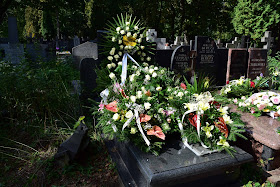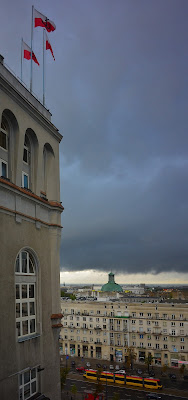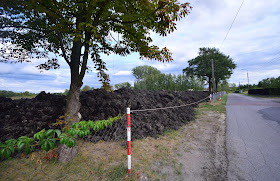Depends where you're located, depends on your history. If you're from around here, Central Europe, and you've had experience of the Russian boot stamping repeatedly down on the face of your nation - then it's easy - the answer to the question of the biggest threat to Europe is Mr Putin.
He'll soon be in Moldova; he has his eyes set on Ukraine, Georgia, Latvia, Estonia, Lithuania, Finland, Poland... anywhere that was once part of the Russian Empire at the height of its glory. Here, we've experienced the evil of Russian hegemony, the sending of children to labour camps on account of their parents being deemed 'class enemies'.
But ask a Brit or a Frenchman where the biggest threat to Europe lies - and they will answer ISIS. A group of barbarians devoid of any humanity, ready to saw off the head of anyone who does not believe that the literal word of God has been handed down through the words of the Prophet Mohammed.
The difference is that Central and Eastern Europe has felt Russia's boot on its face, while Western Europe has only felt the threat of ISIS vicariously.
Apart from polonium poisoning of Russian dissidents and aerial incursions by Russian bombers, Britons have little idea of what threat Russian nationalism poses to European civilisation. Their attention is turned instead to the similarly egregious behaviour of Islamic fundamentalism.
Here in Poland, Islamic fundamentalism is not a big problem. The presence of Iskander missiles in Kaliningrad is. For Britons, it's the other way around. The presence of Salafist preachers in the heart of Birmingham, recruiting adherents to its intolerant ideology, of the Rochdale groomings - these are the vital issues that affect the nation today.
Poland has had its Islamic minority - in the presence of Tartars in the north-east - since the 17th Century. They have always pledged their allegiance to the Polish state, and there have never been any problems in their neighbourly relationships with Poles. But then Poland never colonised any Islamic nations, so there's no guilt complex. And so Poland is able to ask its Muslim citizens to stay loyal. And to date, they have been. As have been the Muslim migrants from the Middle East, who have been coming to Poland - in limited numbers - since the 1970s.
The presence of millions of refugees from the conflicts of the Middle East, pressing against the borders of the EU has raised alarm bells across Poland. For each citizen ready to welcome them, there are five or six viewing them as a threat. The vast majority of these migrants are running away from the same barbarism that is abhorred by all civilised people.
All of this should be viewed in the context of Brexit - the Quixotic vision of a glorious Britain, free at last from the shackles of Continental Europe, regaining its dominant global position from 150 years ago, by democratically wriggling free from the constraints of Brussels' bureaucrats.
Since July this year, the percentage of Britons polled who say they wish to leave the EU has overtaken those who say they wish to remain in.
Why? The refugee crisis.
Images of people of Arab ethnicity, wishing to enter the EU (and that includes Britain) in search of safety and a better life, has tipped the scales in the Brexit debate. It's no longer the Polish plumber taking our Wayne's job - it's the mass of ISIS operatives disguised as ordinary Syrian bakers and doctors fleeing from mayhem - that's what's swaying the argument.
But if you live in Poland, you'll have in your immediate family victims of Stalin's repressions. ISIS is a distant and vague threat. There's been no 9/11, no 7/7 here. These attacks claimed thousands of lives. Yet here, Poles have been subjected to mass deportations to the GULAG - hundreds of thousands of them - there have been the 45 years during which the economy has been held back through brutal stupidity imposed by Moscow. Many millions of Polish lives were blighted by the communist regime, which stunted their life prospects. This is tangible, real.
Yes, there were the Nazis. But since the end of WW2, Federal Germany has begged its victims for forgiveness. My Ciocia Jadzia who died last week having survived Auschwitz, lived to the end of her days receiving a German state pension. My mother, deported to a Northern Russian lumber camp at the age of 12, has never even had a word of apology from the USSR or its successor state.
In order for Poland to stand strong against the threat of resurgent Russian nationalism being whipped up by Putin, it needs a strong NATO and a strong EU. A strong EU needs to be composed of strong-willed nations - Germany, France, Italy (...er...) and of course Britain. The UK has for too long wavered, prevaricated, looked on non-issues like straight bananas and metric martyrs, rather than doing what it did in the 16th, 17th, 18th and 19th Centuries - striven to take the lead in Europe.
Poland needs a strong Britain in a strong Europe.
Why is Mr Putin currently meddling in Syria? Apart from the other geopolitical goals in his black heart, there's the jolly sight (for him) of hundreds of thousands of displaced persons from the Middle East causing divisions between the leaders of the EU's 28 member states. Great! More Russian troops in Syria = an even bigger bloody mess = even more refugees = even bigger problems for the EU.
And what's happening in Britain? Isolationism. It reminds me of what was going on in the USA in the late 1930s. Many voices (Henry Ford, Charles Lindbergh, Fr. Charles Coughlin) urged America to stay out of WWII. Yet the urge to protect civilisation from barbarism prevailed.
Today, the forces of barbarism are seen in the Middle East and in the Kremlin. Which is the greater threat to civilisation?
It all depends of where you live - and what your family's experience has been.
Poland should be doing all it can to encourage the UK to remain in the EU - for the good of all mankind.
This time last year:
Scenarios for change in Russia
This time two years ago:
A new bus for Jeziorki - the 809 to Bobrowiec
This time four years ago:
Bunker in Powiśle
This time five years ago:
Sunshine brings out the best in everything
This time seven years ago:
There must be a better way (3)






























